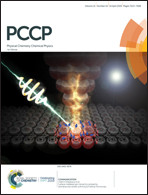Computational understanding of the structural and electronic properties of the GeS–graphene contact
Abstract
Two-dimensional (2D) metal–semiconductor junctions have shown significant potential for nanoelectronic and optoelectronic applications. Herein, the structural and electronic properties of a germanium monosulfide/graphene (GeS/G) van der Waals (vdW) heterostructure were explored using first-principles calculations. It was discovered that the structural rigidity and mechanical anisotropy of GeS could be significantly improved by loading graphene. In addition, the intrinsic characteristics of the atomic layer GeS and graphene were well preserved, and the formation of a p-type Schottky contact in the equilibrium state was demonstrated; moreover, the Schottky barrier height of the interface was sensitive to the external condition and could be reduced to zero via applying normal strain or a perpendicular electric field. These insightful results pave the way for experimental research and the design of other 2D nanomaterial-based electronic and optoelectronic devices.



 Please wait while we load your content...
Please wait while we load your content...